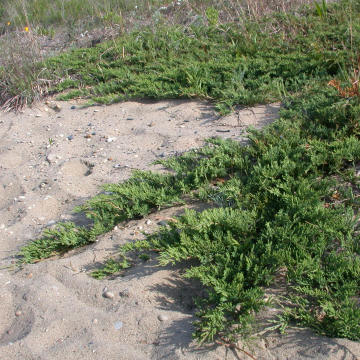

Juniperus horizontalis - (image 1 of 3)
Taxonomy
Family: Cupressaceae
Habitat
Sandy and rocky soils, dunes, sandy prairies.
Associates
On low dunes near Lake Michigan, consistently found with Arctostaphylos uva-ursi coactilis. Also found with many of the same associates listed under J. communis.
Distribution
Northern tier of the country; Atlantic coast, Great Lakes and upper Great Plains.
Morphology
Sprawling to procumbent or prostrate evergreen shrub. Leaves usually opposite, nearly all scale-like and appressed-imbricated, a few subulate but less than 5mm long. Flowers dioecious. Fruit a fleshy, berry-like cone, to 1/3" across, pale green-blue when young and waxy blue-purple when mature; seeds 2 or 3.
Notes
Flowers late April to early May
Wetland indicator: Upland, Facultative-
The foliage is green during the growing season and turns blue-purple in the winter. Some specimens can look almost metallic in winter color. A popular ground cover for open, sunny areas in dry soil. It seems to achieve it's best form in loose or sandy soils, that or the ones I have seen on the dunes of Lake Michigan just trail better than many of the cultivars in commerce. The fruits can be ornamental when abundant, although fruit is rarely produced on cultivated plants. Salt tolerant. Can look really bad when planted in the wrong spot, such as in too much shade or heavy soil.
References
Dirr, Michael A. 1998. Manual of Woody Landscape Plants:
Their Identification, Ornamental Characteristics, Culture, Propagation and Uses.
5th ed. Champaign, Illinois: Stipes Publishing L.L.C.
Swink, F. and G. Wilhelm. 1994. Plants of the Chicago Region.
Indiana Academy of Science. The Morton Arboretum. Lisle, Illinois.
|
Michael Hough © 2005 |